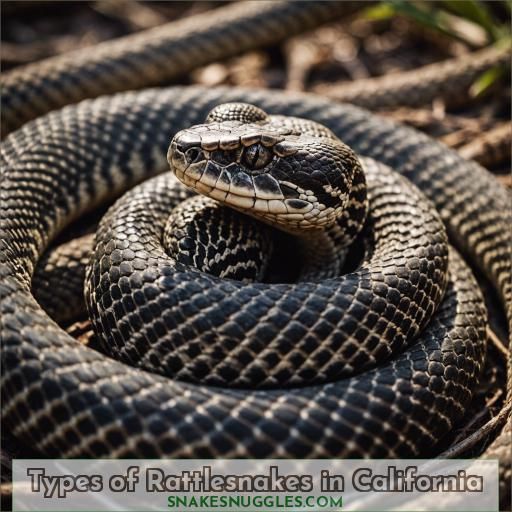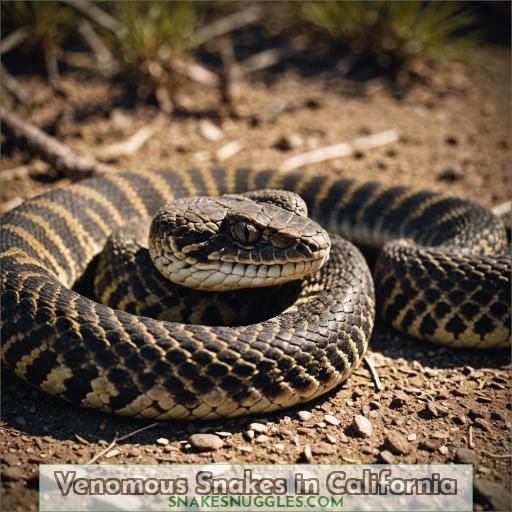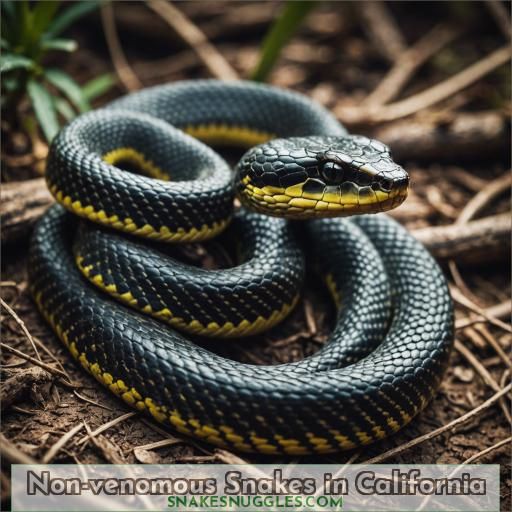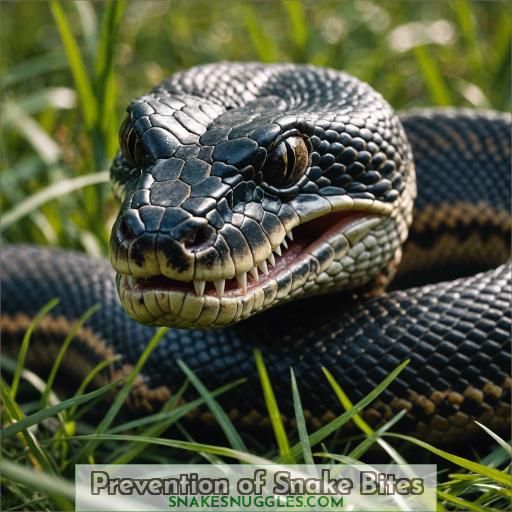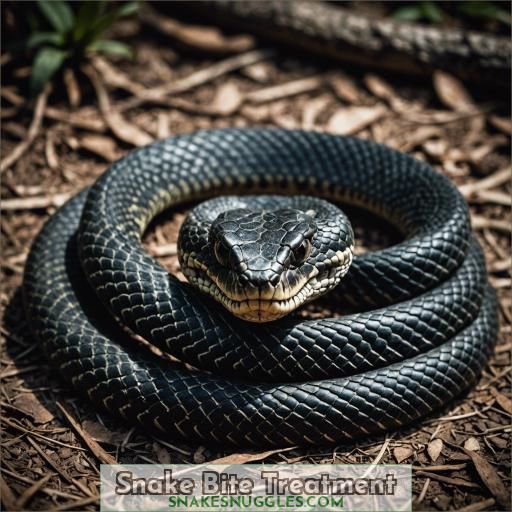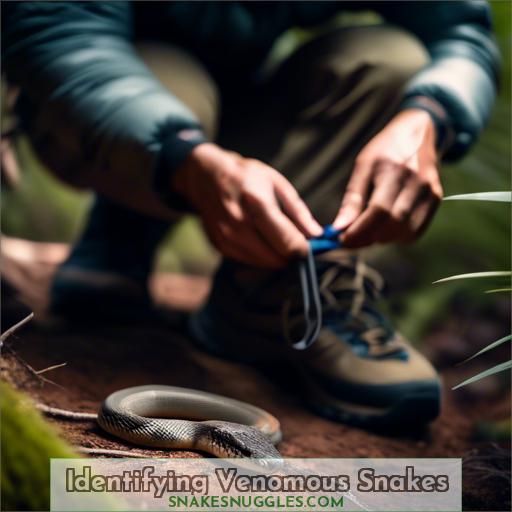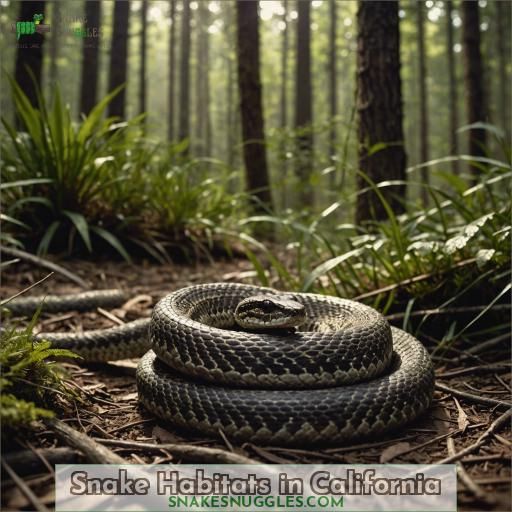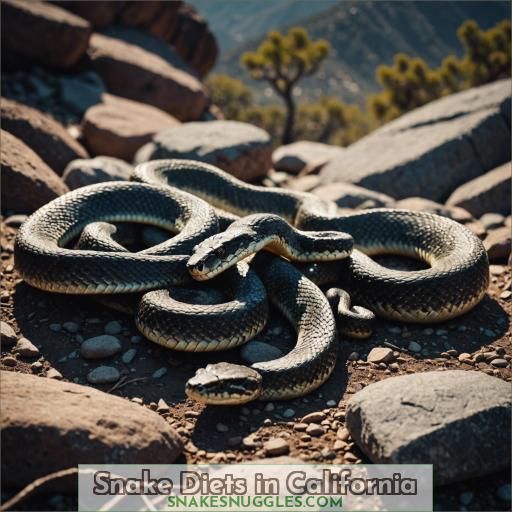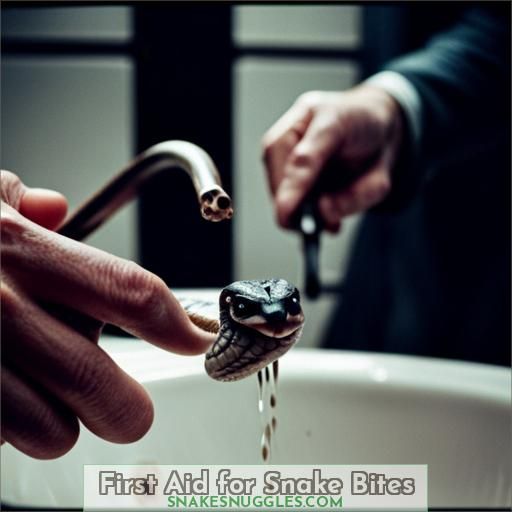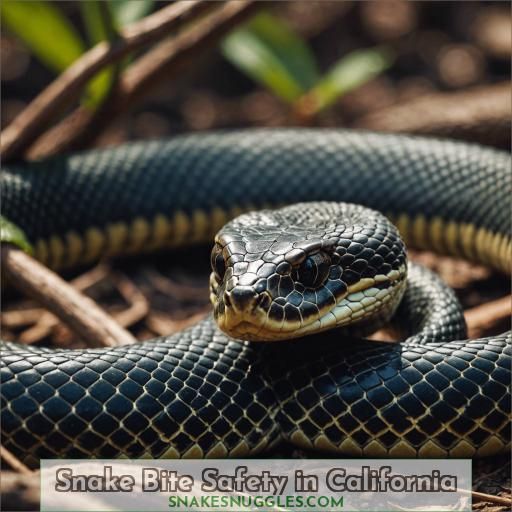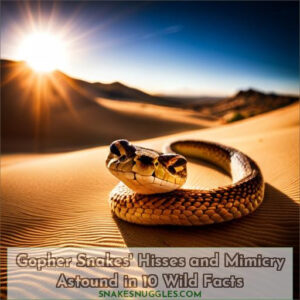This site is supported by our readers. We may earn a commission, at no cost to you, if you purchase through links.
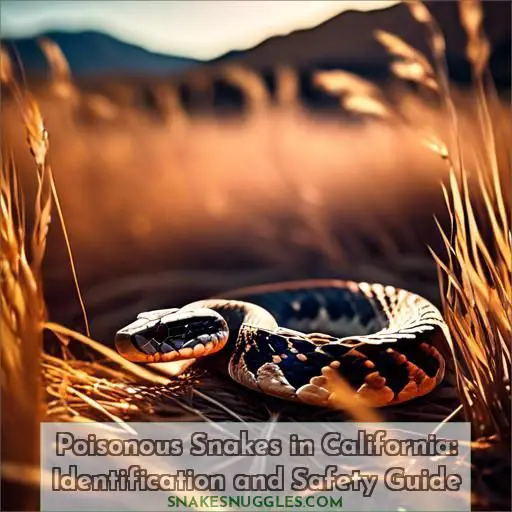
As you venture into the untamed wilderness of California, it’s essential to be cognizant of the poisonous serpents that reside within its borders. Among the most hazardous are the Mojave rattlesnake, renowned for its potent neurotoxic venom, and the Western diamond-backed rattlesnake, infamous for its frequent bites each year.
The notable Northern Pacific rattlesnake, with its triangular head and distinctive rattle, is another venomous species to be wary of. Appropriate measures, such as wearing durable boots and adhering to designated trails, can assist in preventing encounters with these venomous snakes.
Embark on a deeper exploration to unravel the full spectrum of California’s poisonous reptilian inhabitants and the strategies to ensure your safety.
Table Of Contents
- Key Takeaways
- Types of Rattlesnakes in California
- Venomous Snakes in California
- Non-venomous Snakes in California
- Prevention of Snake Bites
- Snake Bite Treatment
- Identifying Venomous Snakes
- Snake Habitats in California
- Snake Diets in California
- First Aid for Snake Bites
- Snake Bite Safety in California
- Frequently Asked Questions (FAQs)
- Conclusion
Key Takeaways
- California is home to a diverse array of venomous rattlesnakes, including the Northern Pacific, Northern Mojave, Southern Pacific, and Western Diamondback rattlesnakes.
- The venom of these snakes can cause swelling, pain, paralysis, and even death.
- To avoid encounters with venomous snakes, wear appropriate footwear, stay on designated paths, watch where you’re going, and avoid reaching into concealed areas.
- Immediate veterinary care is essential for all rattlesnake bites, and rattlesnake avoidance training for dogs is recommended.
Types of Rattlesnakes in California
California is home to a diverse array of venomous rattlesnakes, including the Northern Pacific, Northern Mojave, Southern Pacific, and Western Diamondback rattlesnakes. These snakes possess potent hemotoxic or neurotoxic venom and can pose a serious threat if encountered, underscoring the importance of awareness and caution when exploring California’s natural landscapes.
Northern Pacific Rattlesnake
In Northern California, you’ll find the Northern Pacific Rattlesnake (Crotalus oreganus). This venomous snake is a member of the rattlesnake family and is known for its distinct rattle.
It’s a powerful predator, with a venom that can cause swelling and pain. To avoid a bite, keep an eye out for their triangular head and rattle.
Northern Mojave Rattlesnake
The Northern Mojave Rattlesnake, also known as the Mojave Green, is a formidable serpent found in the Mojave Desert. Its neurotoxic venom is among the most potent of all rattlesnakes, making immediate medical attention imperative if bitten. Recognizable by its distinct coloration, this crotalus mitchelli subspecies demands caution and respect from all who venture into its domain.
| Venom Type | Habitat | Appearance | Prey | Bite Severity |
|---|---|---|---|---|
| Neurotoxic | Mojave Desert | Green/Brown Camouflage | Rodents, Lizards | Extremely Dangerous |
Southern Pacific Rattlesnake
Southern Pacific Rattlesnakes (Crotalus helleri) are a subspecies of rattlesnakes found in southern California and northern Baja California, Mexico. They’re known for their unique venom, which is a mix of hemotoxic and neurotoxic components. The venom is particularly dangerous because it can cause rapid paralysis and difficulty breathing, in addition to the usual symptoms of hemotoxic venom such as swelling and blood loss.
Here are three key points about Southern Pacific Rattlesnakes:
- Habitat: These snakes live in a variety of habitats, including grasslands, forests, rocky hillsides, and coastal scrub. They’re nocturnal during the hotter summer nights but may also be active during the spring and fall.
- Venom: The venom of the Southern Pacific Rattlesnake is unique, with a combination of hemotoxic and neurotoxic components. This makes their bites particularly dangerous, as they can cause rapid paralysis and difficulty breathing, in addition to the usual symptoms of hemotoxic venom such as swelling and blood loss.
- Conservation and Threats: The Southern Pacific Rattlesnake isn’t currently threatened, but they face threats from habitat loss and human encounters. They’re also victims of vehicles while traveling across roads.
Western Diamondback Rattlesnake
The Western Diamondback Rattlesnake is a common and dangerous species found in California and other southwestern states. This snake has a triangular head with two dark diagonal lines on each side, running from the eyes to the jaws. The back is covered in dark diamond-shaped patterns, and the tail has black and white bands. The venom of the Western Diamondback Rattlesnake is primarily hemotoxic, causing damage to blood vessels and leading to swelling and blood loss.
The bite severity of this species can vary depending on the snake’s size, the amount of venom injected, and the dog’s size. While 20-25% of rattlesnake bites are dry (no venom injected), immediate veterinary care is essential for all bites. Treatment includes IV fluids for circulatory collapse, antivenin within 4 hours, antihistamines for reactions, and blood transfusions if necessary.
To prevent snake bites, rattlesnake avoidance training for dogs is recommended, along with vaccination for partial protection. Wear appropriate footwear, stay on designated paths, watch where you’re going, and avoid reaching into concealed areas or surprising snakes.
Red Diamond Rattlesnake
Meet the Red Diamond Rattlesnake (Crotalus cerastes), a venomous snake that calls California’s coastal zones home. With its least potent venom, it’s not as dangerous as its cousins, but don’t underestimate its bite. Here are four things you should know:
- Least Potent Venom: Red Diamond Rattlesnakes have the least potent venom among rattlesnakes, but it can still cause discomfort and pain.
- Coastal Zones: These snakes prefer coastal areas, so if you’re near the shore, be on the lookout.
- California Resident: The Red Diamond Rattlesnake is native to California, making it a common sight in the state.
- Venomous: Despite its less potent venom, the Red Diamond Rattlesnake is still venomous and should be treated with caution.
Sidewinder
The Sidewinder, also known as Crotalus cerastes, is a venomous snake found in the deserts of the southwestern United States and northwestern Mexico. This rattlesnake is known for its unique movement, which allows it to move sideways without lifting its body off the ground.
Its venom is hemotoxic, causing swelling and blood loss, but its bite is less potent than that of larger rattlesnakes. Sidewinders are most active at night and prefer rocky, sandy habitats. They feed on lizards and rodents.
To avoid sidewinder bites, wear appropriate footwear, stay on designated paths, and avoid reaching into concealed areas.
Mojave Desert Sidewinder
In the Mojave Desert, the Sidewinder Rattlesnake is a common sight.
This snake is known for its unique sidewinding locomotion, which allows it to move quickly across sandy terrain.
The Mojave Desert Sidewinder’s venom can cause severe pain and swelling, and in some cases, even death.
To prevent bites, stay on designated paths, avoid reaching into concealed areas, and watch where you’re going.
If you encounter a California Kingsnake, which resembles the Sidewinder but is non-venomous, it’s best to leave it alone.
Colorado Desert Sidewinder
Colorado Desert Sidewinders (Crotalus cerastes laterorepens) are a subspecies of the sidewinder rattlesnake found in the southwestern United States and northern Mexico. These snakes are well adapted to desert environments, utilizing camouflage techniques to blend in with their surroundings. Here are four key points about Colorado Desert Sidewinders:
- Camouflage: Their overall color is sandy brown, with elliptical markings that help them disappear among the twigs, rocks, and other detritus on the desert floor.
- Horned Protective Scales: The sidewinder has a protective scale above each of its eyes, shaped like horns, which deflect blowing sand and protect its eyes from the harsh desert sun.
- Venom Potency: Although their venom is less potent than that of the Mojave rattlesnake, it’s still capable of causing serious symptoms in humans, including nausea, chills, coagulopathy, dizziness, and shock.
- Bite Statistics: While the venom is less potent, the frequency of bites may be higher due to their smaller size and the abundance of prey in desert environments.
To avoid encounters with Colorado Desert Sidewinders, it’s essential to wear appropriate footwear, stay on designated paths, watch where you’re going, and avoid reaching into concealed areas where snakes may be hiding. If you encounter a sidewinder, don’t attempt to handle or capture it, as it may strike in defense.
Panamint Rattlesnake
The Panamint Rattlesnake, a venomous species native to California, is known for its distinctive coloration and behavior.
These snakes inhabit the desert habitats of the Panamint Range, feeding on small mammals and lizards.
To identify a Panamint Rattlesnake, look for its triangular head, rattling tail, and distinctive color pattern.
Despite their venomous nature, Panamint Rattlesnakes are generally wary of humans and will only bite in self-defense.
To avoid encounters, always wear appropriate footwear, stay on designated paths, and avoid reaching into concealed areas.
Lyresnake
The Lyresnake is a venomous snake species found in California.
It is known for its unique appearance, with a lyre-shaped head and a distinctive pattern of black and white bands.
Despite its venom, the Lyresnake is relatively small and not as dangerous as other rattlesnakes.
Its fangs are not as long or rigid as those of the Mojave Rattlesnake, and its venom is considered milder.
The Lyresnake’s habitat includes coastal zones, mountains, and deserts.
Its diet consists of small mammals, lizards, and snakes.
While it is not as dangerous as some other venomous snakes, it is still important to avoid encounters with the Lyresnake.
Venomous Snakes in California
California is home to several venomous snake species that require caution and awareness. The Mojave Rattlesnake, with its potent neurotoxic venom, the Southwestern Speckled Rattlesnake, notorious for causing extreme swelling and pain from its bites, and the widespread Western Diamond-backed Rattlesnake, responsible for numerous snakebites annually, are among the most notable venomous snakes found in the state.
Mojave Rattlesnake
The Mojave Rattlesnake is one of the most venomous snakes in California, known for its neurotoxic venom that can cause paralysis.
These snakes prefer high desert habitats, such as sagebrush and Joshua tree forests, and are most active during the day.
Bite severity depends on the snake’s size and the amount of venom injected, but immediate veterinary care is vital.
First aid measures include staying calm, calling for help, and keeping the bite below heart level.
Southwestern Speckled Rattlesnake
The Southwestern Speckled Rattlesnake is a venomous snake found in rocky hillsides, canyons, and talus slopes.
Its bite causes extreme swelling and pain.
Its coloration varies from light to dark brown with speckles.
To prevent bites, follow safety guidelines, such as wearing appropriate footwear and avoiding reaching into concealed areas.
Conservation initiatives are essential to protect habitats and prevent habitat destruction.
Western Diamond-backed Rattlesnake
You’re treading into Western Diamond-backed Rattlesnake territory, where venom severity isn’t just a scare tactic—it’s a reality.
These slithery adversaries prefer dining on small mammals, showing no mercy.
Their habitat might just overlap with your favorite hiking trail.
Known for their hair-trigger aggression, encountering one could lead to a quick dash for antivenom.
So, lace up those boots tightly and stay vigilant!
Non-venomous Snakes in California
While many snakes in California are venomous and potentially dangerous, several species are non-venomous and pose little threat to humans. Among these harmless serpents are the California king snake, known for its immunity to rattlesnake venom.
The coachwhip, a slender and agile snake, may defensively bite but lacks venom.
The garter snake, a common sight in gardens and fields, possesses only a mild neurotoxin insufficient to cause serious harm.
California King Snake
The California King Snake, a non-venomous species, is often mistaken for a venomous snake due to its black and white banding pattern. It’s harmless to humans and even resistant to rattlesnake venom.
These snakes primarily eat small rodents and lizards. They’re also known for their venom resistance and have a unique diet, which includes the venomous Mojave Rattlesnake.
Despite their harmless nature, they can bite if provoked or handled.
Coachwhip
The Coachwhip snake, a non-venomous species found in California, is known for its long, slender body and agile movements. Here’s what you need to know about this snake:
- Habitat: Coachwhips inhabit a variety of environments, from deserts to forests.
- Diet: They primarily feed on small rodents, lizards, and other reptiles.
- Predators: Raccoons, skunks, and birds of prey are among the Coachwhip’s predators.
- Conservation: The Coachwhip isn’t considered threatened or endangered.
- Behavior: Despite its fearsome appearance, the Coachwhip is generally not aggressive with humans.
- Interesting Fact: The Coachwhip is capable of delivering a painful bite, but it’s harmless to humans.
Garter Snake
Garter snakes, often spotted in your garden, are the peacekeepers of the snake world. Their venom? A mere tickle to humans, but a game-changer in their diet of slugs and insects. These serpents prefer the comfort of moist environments, weaving through grass with ease. Their behavior? Shy and elusive, making garter snake bites as rare as finding a four-leaf clover.
Checkered Garter Snake
The Checkered Garter Snake, a non-venomous species, is a common sight in California. With its distinctive black and white checkered pattern, this snake is a popular choice for many snake enthusiasts.
These snakes are typically found near water sources and feed on small fish, amphibians, and insects. They are known to be active during the day and are relatively passive in nature.
Common Garter Snake
Garter snakes are a common sight in many North American habitats, and they’re known for their distinctive stripes. These snakes aren’t venomous, but they can bite if provoked. Here’s what you need to know about the common garter snake:
Identification: Garter snakes have a distinctive stripe along their entire length, making them easy to identify. They’re usually between 23 and 30 inches long, with slender to moderately stout bodies. Their scales are keeled, and they’ve a single anal plate. Their dorsum (back) can be brown to black, and their belly is usually pale yellow to greenish, often with black spots on the border of each belly scale.
Habitat: Garter snakes are generalists and can inhabit a wide variety of habitats, including woodlands, meadows, grassy knolls, and wetlands. They’re most abundant when a water source is nearby.
Diet: Garter snakes feed mostly on fishes, amphibians, and earthworms. They immobilize their prey with their sharp teeth and quick reflexes. Some species have a mild neurotoxin in their saliva that causes paralysis, making small prey easier to swallow.
Behavior: Garter snakes are generally active during the day and are relatively fast-moving. They’re shy and withdrawn, but they’ll give off a bad-smelling musk when threatened. They hibernate in the winter in dens in large groups, often with hundreds of snakes together.
Conservation: The main threat to garter snakes is habitat loss, both to their summer and winter habitats. Pesticide use is also a concern, as it harms snakes and poisons their prey. Snake road kills also have an impact, as snakes seek the heated asphalt to warm their cold-blooded bodies.
Prevention: To prevent encounters with garter snakes, it’s best to leave or create habitat suitable for them in your own backyard. This includes leaving a quarter of your garden wild, providing damp, shady areas for snakes to cool off in the summer, and offering them shelter and protection from predators.
Prevention of Snake Bites
To avoid snakebites in California, be proactive. Get your dog trained in rattlesnake avoidance, and be sure to vaccinate them before snake season starts – this provides partial protection but doesn’t replace emergency care. When hiking, always wear sturdy boots, stay on marked trails, and be mindful of where you’re stepping to avoid surprising any venomous snakes.
Rattlesnake Avoidance Training for Dogs
Rattlesnake avoidance training for dogs is an essential prevention method for snake bites. This training involves teaching your dog to identify and avoid venomous snakes.
Effective training methods include positive reinforcement with rewards and consistent reinforcement of obedience. The training should be customized to your dog’s breed, age, and unique needs.
With proper training, your dog can learn to identify and avoid rattlesnakes, reducing the likelihood of a potentially hazardous encounter.
Vaccination
As a dog owner in California, it’s vital to be cognizant of the rattlesnake vaccine, which can aid in safeguarding your pet from the potentially life-threatening consequences of a snake bite. The vaccine is formulated to stimulate your dog’s immune system to produce antibodies against rattlesnake venom, offering a layer of protection against its effects. However, it’s paramount to recognize that the vaccine doesn’t replace prompt veterinary treatment in the event of a bite.
The vaccine is most effective when administered in a series of two or three doses, with the initial doses separated by approximately 30 days. Dogs weighing over 100 lbs or under 25 lbs may require a three-dose initial series. The protection provided by the vaccine peaks about 30 to 45 days after boosters and endures for approximately six months. It’s advisable to administer vaccination boosters approximately 30 days prior to the onset of the snake season to guarantee optimal protection.
While the vaccine can provide some protection, it’s not infallible. Elements such as the bite’s location, the snake’s species, and the quantity of venom injected can impact its efficacy. Furthermore, the vaccine doesn’t protect against the venom of water moccasins, coral snakes, or the Mojave rattlesnake.
It’s also crucial to be aware that the vaccine may have side effects, including lumps at the injection site, which can be alleviated with warm moist compresses, antibiotics, and pain medication if necessary. Systemic reactions, such as flu-like symptoms, are reported in less than one in 3,000 vaccinated dogs and typically resolve on their own.
Wear Appropriate Footwear
When trekking through snake country, your choice of footwear can be a real lifesaver. Consider these tips:
- Opt for sturdy, high-ankle boots; they’re like fortresses for your feet.
- Snake gaiters are the knights in shining armor, guarding against venomous bites.
- On rocky hiking trails, thick-soled boots can be your trusty steed.
- Remember, flip-flops are a definite no-go in viper territory.
Stay on Designated Paths
Stay on designated paths whenever possible to minimize your exposure to snake presence. Concealed areas, such as tall grass or shrubs, are more likely to harbor snakes. By sticking to visible trails, you can maintain a safer distance from these creatures. Off-trail safety is paramount, so always be aware of your surroundings and the potential for snake encounters.
Watch Where You Are Going
When embarking on journeys into snake habitats, it’s essential to remain attentive and observe your path to avert snake bites. Be on the lookout for indications of snake presence, such as rattling, coiled bodies, or slithering movements.
Be cognizant of your surroundings, particularly in areas where snakes are known to dwell. By maintaining vigilance and caution, you can substantially minimize the likelihood of encountering a venomous snake.
Avoid Reaching Into Concealed Areas
When exploring the outdoors in California, it’s essential to be aware of snake hiding spots to avoid encounters with venomous species. Snakes often seek shelter in dark, concealed areas such as holes, nests, and vegetation. Be cautious when reaching into these spots, as you might accidentally disturb a snake resting there. Here are some tips to help you avoid snake holes and reduce the risk of bites:
- Avoid reaching into holes or nests: Snakes may be resting in these areas, and you could accidentally disturb them, leading to a bite.
- Be aware of vegetation: Snakes often use plants as cover, so be cautious when moving through dense vegetation.
- Inspect rock crevices: Snakes may hide in small cracks or crevices, so take a close look before reaching into these areas.
- Stay away from bushy areas: Snakes often use bushes for shelter and concealment, so avoid areas with heavy vegetation.
Avoid Surprising Snakes
To avert startling snakes, it’s imperative to comprehend their behavioral patterns and cautionary signals. Snakes are more apt to strike when they perceive a threat or are taken by surprise. Here are some suggestions to help you evade surprising snakes:
- Know the trail: Research the trail in advance to grasp the potential risks, including the existence of snakes.
- Vibrations are key: Snakes tend to slither away when they detect the vibrations of your footsteps. Be attentive to your step and step on logs or rocks so they sense the vibration.
- Watch your step: Proceed with caution when stepping on logs or rocks, as stepping over them can surprise a snake and cause it to strike instantaneously.
- Consider using hiking poles: Hiking poles can aid in alerting snakes to your presence and provide additional vibration to discourage them from striking.
- Wear sturdy shoes and socks: Long pants can also aid in reducing the amount of venom injected if you’re bitten.
- Never handle a snake: Even a deceased snake can still pose a threat of biting.
- Snakes will strike for protection: If surprised, frightened, or threatened, snakes will strike to safeguard themselves.
- Consider emergency supplies: Carry soap, water, a cell phone, and other essentials in the event of a snake encounter.
- Don’t let your fear ruin your hike: Have strategies to avoid snakes and a plan for if you were to encounter one.
Snake Bite Treatment
If you’re bitten by a venomous snake in California, remain calm and call for immediate medical assistance. Avoid applying a tourniquet and keep the bite below heart level, as these actions can worsen the injury.
Stay Calm
If you’re bitten by a snake, keeping your cool is key. Calm behavior slows the spread of venom, so take a deep breath and focus on staying hydrated. Avoiding panic isn’t just a cliché—it’s critical. Control your emotions; remember, a clear head can recognize the signs of anaphylaxis. Stay still, stay smart, and stay alive.
Call for Help
When a snake bite occurs**, the first step is to remain composed and summon assistance. This is imperative as the severity of the bite can vary depending on the snake species, the size of the dog, and the amount of venom injected.
Prompt veterinary care is essential, and the sooner antivenom can be administered, the better the odds of mitigating irreversible damage from the venom. If you’re uncertain about the snake’s venomousness, treat the bite as a puncture wound and seek medical attention.
While awaiting assistance, keep the person calm and tranquil, avoiding any nonessential movement to prevent the dissemination of venom.
Remove Tight Clothing or Jewelry Near the Bite
When a snake bite occurs, it’s essential to remove any tight clothing or constraining jewelry near the bite. This step aids in preventing further harm or constriction, which could exacerbate the situation. Loose clothing and jewelry should be worn to avert any potential complications.
Keep the Bite Below Heart Level
If you’re bitten by a venomous snake, keep the bite below your heart level to slow venom flow. This can help reduce swelling and prevent the venom from spreading. It’s essential to maintain heart level positioning until you can receive appropriate treatment.
Do Not Apply a Tourniquet
Do not apply a tourniquet when treating a snake bite. Tourniquets can cause tissue damage and increase the risk of infection, as well as potentially delaying the necessary medical attention.
Instead, focus on keeping the victim calm and elevating the affected limb.
Transport the victim to a hospital as quickly as possible for proper antivenin treatment. This is important, as tourniquets are a common misconception and can actually worsen the situation.
Identifying Venomous Snakes
After acquiring knowledge of how to manage a snake bite, it’s paramount to possess the ability to discern the potential danger before it manifests. Venomous snakes in California, such as the Mojave with its neurotoxic venom inducing paralysis, can be distinguished by their fang morphology and the grave consequences of their bites.
These snakes frequently target small mammals, unlike their non-venomous counterparts. Comprehending their dietary habits can also be beneficial.
Keep in mind, not all snakes pose a threat to your well-being, but understanding which ones may do so enhances your control and safety during outdoor excursions.
Snake Habitats in California
In California, rattlesnakes and other venomous snakes inhabit a variety of habitats, each with its own unique characteristics.
Mojave Rattlesnakes are found in high desert areas with sagebrush and Joshua tree forests. Red Diamond Rattlesnakes prefer coastal zones, mountains, and deserts. Sidewinders are native to the deserts of the Southwestern US and Northwestern Mexico. Western Diamond-backed Rattlesnakes are most commonly found in central Arkansas to southwestern and central California.
These snakes have developed excellent camouflage, using their tail rattles to warn predators and potential threats. They also exhibit hibernation patterns and mating behaviors, which vary depending on the species.
Understanding these habitats can help you avoid encounters with venomous snakes and stay safe in their environments.
Snake Diets in California
Snakes in California have diverse diets, which can vary based on the season and the specific snake species. Understanding their food habits can help you identify and avoid them. Here are some key points about snake diets in California:
- Venom gland function: Venom glands in snakes produce toxic substances that help them immobilize or kill their prey, which is then swallowed whole.
- Snake hunting techniques: Snakes use their sense of smell, vision, and body heat to locate prey. They often ambush their victims, using their unique body shapes and movements to blend into their environment.
- Seasonal variation in diets: Some snakes, like the Mojave Rattlesnake, primarily feed on small rodents during the winter, while others, like the Western Diamondback Rattlesnake, may switch to birds during the summer months.
- Prey species preference: Different snake species have different prey preferences. For example, the Southwestern Speckled Rattlesnake feeds on small mammals, while the California King Snake prefers rodents and other snakes.
First Aid for Snake Bites
When a venomous species strikes, immediate treatment is vital**. Maintain composure and seek assistance.
Remove any constricted garments or adornments adjacent to the bite, and position the bite lower than the heart’s level. Refrain from applying a tourniquet.
For canines, obtain veterinary attention within 4 hours for antivenom administration. Bite severity varies contingent upon the snake species, canine size, and venom quantity. Identifying the snake’s species can aid in determining the urgency of treatment.
Snake Bite Safety in California
In California, snake bite statistics can be alarming, with venomous snakes like the Mojave Rattlesnake and Southwestern Speckled Rattlesnake causing severe injuries. To prevent snake bites, consider rattlesnake avoidance training for dogs and vaccination for partial protection.
Wear appropriate footwear, stay on designated paths, and watch where you’re going. Avoid reaching into concealed areas and surprising snakes.
If bitten, stay calm, call for help, remove tight clothing or jewelry, and keep the bite below heart level. Don’t apply a tourniquet. Snake bite treatment is essential for recovery.
Frequently Asked Questions (FAQs)
How do weather conditions affect snake activity?
When it’s hot and dry, snakes become more active as they seek out water and prey. But on rainy days, they’ll often hide away to avoid the downpours. The weather’s a big factor in their movements!
Can snake venom be used for medical purposes?
Did you know venom can actually save lives? Snake venoms contain unique compounds that doctors use to develop life-saving medications. From blood thinners to cancer treatments, nature’s toxins pack a powerful punch – but in the right hands.
What legal protections exist for Californias snakes?
California safeguards its snakes through legal protection – most venomous species can’t be captured or harmed unless permitted. This shields these essential critters, keeping you and them safe. Pretty neat, huh?
How to safely remove a snake from your home?
Snakes in your home? Don’t panic! Gently corral the slippery serpent with a long stick, scoop it into a sturdy container, and release it outdoors – a safe, humane solution to this wild encounter.
What are the long-term effects of snake bites?
Well, snake bites can lead to serious long-term issues like tissue damage, paralysis, and even organ failure. But don’t worry – with prompt treatment, you can bounce back just fine. Stay vigilant out there!
Conclusion
Certainly, the treacherous world of California’s venomous serpents may seem intimidating, but with vigilance and the right precautions, you can navigate these perilous landscapes unscathed.
Familiarize yourself with the diverse array of poisonous snakes, from the notorious Mojave rattlesnake to the elusive Lyresnake, and equip yourself with the knowledge to identify and avoid these deadly denizens.
Embrace the thrill of exploring California’s wilderness, but do so with a healthy respect for the potent venomous snakes that call it home.

